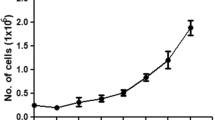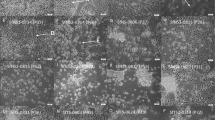Abstract
The red flour beetle, Tribolium castaneum, is a model organism for agricultural and medical research and its complete genome is sequenced. We established a continuously replicating T. castaneum cell line to complement existing physiological, genetic, and genomic research tools. We set up trial cell cultures from egg, pupa, and adult stages as tissue sources and incubated them in six separate cell culture media to determine the optimal combination of tissue source and medium for cell replication. Our most promising culture was generated by co-culturing adult (∼75 %) and pupal tissues in EX-CELL 420 medium containing 9 % FBS. Our new cell culture is designated BCIRL-TcA-CLG1 (TcA) and it has been subcultured more than 90 times. Amplification of genomic DNA with species-specific primers yielded DNA fragments of the expected sizes and with sequences identical to those from the published Tribolium genome. Additionally, we characterized this line using DNA fingerprinting (DAF-PCR) and compared it with three other coleopteran cell lines and its conspecific pupae to confirm identity. Its doubling time is 155.2 hr. Early passages consisted of attached cells and vesicles in suspension, whereas later passages consisted primarily of attached, spherical cells. Similar to other established cell lines, the ploidy of TcA cells was variable, ranging from 20 chromosomes/cell (diploid) to above 30 chromosomes/cell. TcA cells withstood incubation at 40°C for 1 h with no decrease in viability. We recorded increased levels of one heat shock protein (43 kDa) and of the hsp68a transcript following exposure to 40°C. Taken together, this represents the first report of a continuously replicating T. castaneum cell line. We expect the BCIRL-TcA-CLG1 line will become a useful tool in Tribolium research.






Similar content being viewed by others
References
Arakane Y.; Hogenkamp D. G.; Zhu Y. C.; Kramer K. J.; Specht C. A.; Beeman R. W.; Kanost M. R.; Muthukrishnan S. Characterization of two chitin synthase genes of the red flour beetle, Tribolium castaneum, and alternate exon usage in one of the genes during development. Insect Biochem. Molec. Biol. 34: 291–304; 2004.
Asgari S.; Johnson K. N. Insect virology. Caister Academic Press, Norfolk; 2010.
Beeman R. W.; Stuart J. J. A gene for lindane + cyclodiene resistance in the red flour beetle (Coleoptera: Tenebrionidae). J. Econ. Entomol. 83(5): 1745–1751; 1990.
Begum K.; Li B.; Beeman R. W.; Park Y. Functions of ion transport peptide and ion transport peptide-like in the red flour beetle Tribolium castaneum. Insect Biochem. Molec. Biol. 39: 717–725; 2009.
Charpentier C.; Tian L.; Cossette J.; Lery X. Characterization of cell lines developed from the Colorado potato beetle, Leptinotarsa decemlineata Say (Coleoptera: Chrysomelidae). In Vitro Cell Dev Biol — Animal 38: 73–78; 2002.
Crawford A. M. A coleopteran cell line derived from Heteronychus arator (Coleoptera: Scarabaeidae). In Vitro 18(10): 813–816; 1982.
Denell R. Establishment of Tribolium as a genetic model system and its early contributions to evo-devo. Genetics 180: 1779–1786; 2008.
Ding L.; Candido E. P. M. HSP43, a small heat-shock protein localized to specific cells of the vulva and spermatheca in the nematode Caenorhabditis elegans. Biochem. J. 349: 409–412; 2000.
Haliscak J. P.; Beeman R. W. Status of malathion resistance in 5 genera of beetles infesting farm-stored corn, wheat, and oats in the United States. J. Econ. Entomol. 76(4): 717–722; 1983.
Hashimoto Y.; Zhang S.; Blissard G. W. Ao3, a new cell line from eggs of the black witch moth, Ascalapha odorata (Lepidoptera: Noctuidae), is permissive for AcMNPV infection and produces high levels of recombinant proteins. BMC Biotechnol 10(50): 1–16; 2010.
Hoshino K.; Hirose M.; Iwabuchi K. A new insect cell line from the longicorn beetle Plagionotus christophi (Coleoptera: Cerambycidae). In Vitro Cell Dev Biol — Animal 45: 19–22; 2008.
Iwabuchi K. An established cell line from the beetle, Xylotrechus pyrrhoderus (Coleoptera: Cerambycidae). In Vitro Cell Dev Biol – Animal 35: 612–615; 1999.
Kim H. S.; Murphy T.; Xia J.; Caragea D.; Park Y.; Beeman R.; Lorenzen M. D.; Butcher S.; Manak J. R.; Brown S. J. BeetleBase in 2010: revisions to provide comprehensive genomic information for Tribolium castaneum. Nucleic Acids Res. 38: D437–D442; 2010.
Knorr E.; Schmidtberg H.; Vilcinskas A.; Altincicek B. MMPs regulate both development and immunity in the Tribolium model insect. PLoS One 4(3, e4751): 1–14; 2009.
Li B.; Predel R.; Neupert S.; Hauser F.; Tanaka Y.; Cazzamali G.; Williamson M.; Arakane Y.; Verleyen P.; Schoofs L.; Schachtner J.; Grimmelikhuijzen C. J. P.; Park Y. Genomics, transcriptomics, and peptidomics of neuropeptides and protein hormones in the red flour beetle Tribolium castaneum. Genome. Res. 18: 113–122; 2008.
Livak K. J.; Schmittgen T. D. Analysis of relative gene expression data using real-time quantitative PCR and 2-∆∆CT method. Methods 25: 402–408; 2001.
Long S. H.; McIntosh A. H.; Grasela J. J.; Goodman C. L. The establishment of a Colorado potato beetle (Coleoptera: Chrysomelidae) pupal cell line. App. Entomol. Zool. 37: 447–450; 2002.
Lynn D. E. Novel techniques to establish new insect cell lines. In Vitro Cell Dev Biol – Animal 37: 319–321; 2001.
Lynn D. E. Available lepidopteran insect cell lines. In: Murhammer D. W. (ed) Methods in molecular biology series. Baculovirus and insect cell expression protocols. Springer, New York, pp 117–144; 2007.
Lynn D. E.; Stoppleworth A. Established cell lines from the beetle, Diabrotica undecimpunctata (Coleoptera: Chrysomelidae). In Vitro 20(5): 365–368; 1984.
Mahroof R.; Zhu K. Y.; Neven L.; Subramanyam B.; Bai J. Expression patterns of three heat shock protein 70 genes among developmental stages of the red four beetle, Tribolium castaneum (Coleoptera: Tenebrionidae). Comp. Biochem. Physiol. Part A 141: 247–256; 2005a.
Mahroof R.; Zhu K. Y.; Subramanyam B. Changes in expression of heat shock proteins in Tribolium castaneum (Coleoptera: Tenebrionidae) in relation to developmental stage, exposure time, and temperature. Ann. Entomol. Soc. Amer. 98: 100–107; 2005b.
McIntosh A.; Grasela J. J.; Matteria R. L. Identification of insect cell lines by DNA amplification fingerprinting (DAF). Insect Molec. Biol. 5(3): 187–195; 1996.
Mitsuhashi J. Invertebrate tissue culture. Springer, Tokyo; 2002.
Mitsuhashi J. A. Continuous cell line from pupal ovaries of the common cutworm, Spodoptera litura (Lepidoptera: Noctuidae). Appl. Entomol. Zool. 30(1): 75–82; 1995.
Park Y.; Aikins J.; Wang L. J.; Beeman R. W.; Oppert B.; Lord J. C.; Brown S. J.; Lorenzen M. D.; Richards S.; Weinstock G. M.; Gibbs R. A. Analysis of transcriptome data in the red flour beetle, Tribolium castaneum. Insect Biochem Molec Biol 38: 380–386; 2008.
Peel A. D. Forward genetics in Tribolium castaneum: opening new avenues of research in arthropod biology. J Biology 8(106): 1–4; 2009.
Schneider I. Cell lines derived from late embryonic stages of Drosophila melanogaster. Embryo. ex. Morph. 27(2): 353–36; 1972.
Schröder R.; Beermann A.; Wittkopp N.; Lutz R. From development to biodiversity—Tribolium castaneum, an insect model organism for short germband development. Dev. Genes Evol. 218: 119–126; 2008.
Smagghe G.; Goodman C. L.; Stanley D. Insect cell culture and applications to research and pest management. In Vitro Cell Dev Biol - Animal 45: 93–105; 2009.
Stiles B.; McDonald I. C.; Gerst J. W.; Adams T. S.; Newman S. M. Initiation and characterization of five embryonic cell lines from the cotton boll weevil Anthonomus grandis in a commercial serum-free medium. In Vitro Cell Dev Biol — Animal 28: 355–363; 1992.
Stuart J. J.; Mocelin G. Cytogenetics of chromosome rearrangements in Tribolium castaneum. Genome 38: 673–680; 1994.
Tribolium Genome Sequencing Consortium. The genome of the model beetle andn pest Tribolium castaneum. Nature 452: 949–955; 2008.
Zhou Z.; Evans J. D.; Lu Z.; Zhao P.; Williams M.; Sumathipala N.; Hetru C.; Hultmark D.; Jiang H. Comparative genomic analysis of the Tribolium immune system. Genome Biol. 8(R177): 1–16; 2007.
Acknowledgments
Mention of trade names or commercial products in this article is solely for the purpose of providing specific information and does not imply recommendation or endorsement by the U.S. Department of Agriculture. All programs and services of the U.S. Department of Agriculture are offered on a nondiscriminatory basis without regard to race, color, national origin, religion, sex, age, marital status, or handicap.
Author information
Authors and Affiliations
Corresponding author
Additional information
Editor: T. Okamoto
Rights and permissions
About this article
Cite this article
Goodman, C.L., Stanley, D., Ringbauer, J.A. et al. A cell line derived from the red flour beetle Tribolium castaneum (Coleoptera: Tenebrionidae). In Vitro Cell.Dev.Biol.-Animal 48, 426–433 (2012). https://doi.org/10.1007/s11626-012-9524-x
Received:
Accepted:
Published:
Issue Date:
DOI: https://doi.org/10.1007/s11626-012-9524-x




